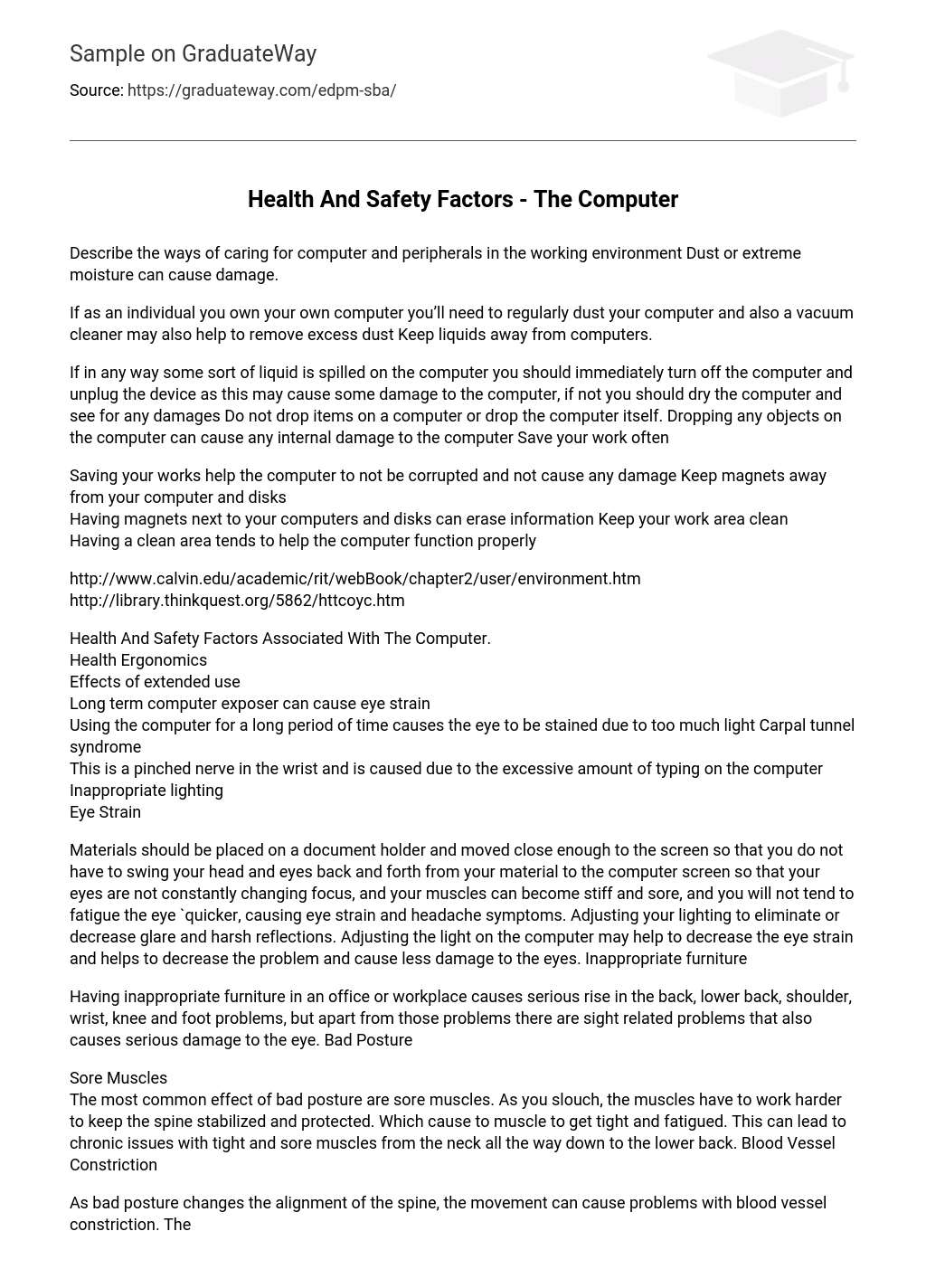Preventing damage from dust or excessive moisture is crucial in protecting computers and peripherals in the workplace.
Regularly dusting and using a vacuum cleaner are essential tasks for individuals who own their own computer to eliminate excessive dust. It is also crucial to keep liquids at a distance from computers.
If any liquid is spilled on the computer, it is important to quickly turn off and disconnect the device to prevent possible damage. If this cannot be done, dry the computer and check for any harm. Avoid dropping objects near or on the computer as it can cause internal damage. Remember to save your work regularly.
To prevent computer corruption and damage, it is crucial to save your work. Additionally, it is important to keep magnets away from your computer and disks as they can erase information. Furthermore, maintaining a clean work area is advantageous for ensuring optimal performance of a computer.
The user environment can be explored through the following links:
– http://www.calvin.edu/academic/rit/webBook/chapter2/user/environment.htm
– http://library.thinkquest.org/5862/httcoyc.htm
The computer poses health and safety risks, including ergonomic concerns. Prolonged computer use can have various effects on the body, such as excessive screen light causing eye strain. Additionally, extended computer usage can result in carpal tunnel syndrome, a pinched nerve in the wrist due to excessive typing. Inadequate lighting also contributes to eye strain.
To ensure optimal comfort and prevent eye fatigue, muscle stiffness, and soreness while working on the computer, it is recommended to use a document holder and position materials close to the screen. This eliminates the need for constant head and eye movement between the material and computer, reducing eye strain and headache symptoms. Additionally, adjusting lighting to minimize glare and reflections can further decrease eye strain and protect the eyes. Lastly, having suitable furniture for work is crucial in ensuring ergonomic comfort.
Improper furniture in an office or workplace can cause physical issues like back pain, lower back pain, shoulder pain, wrist pain, knee pain, and foot problems. It can also lead to vision-related concerns that may result in severe eye damage. Moreover, maintaining poor posture exacerbates these problems.
Sore Muscles
Muscle soreness can be attributed to improper posture, causing added strain on muscles and necessitating increased effort to sustain spinal stability and protection. Consequently, this can lead to tense and fatigued muscles, potentially resulting in persistent issues spanning from the neck down to the lower back. In addition, blood vessel constriction may also arise.
Poor posture can result in misalignment of the spine, leading to constrictions around the spine that obstruct blood flow to muscle cells. This obstruction affects the supply of oxygen and nutrients.
When the spine changes shape and puts pressure on spinal nerves, it can result in nerve constriction. This can cause subluxations or movements that pinch these nerves, leading to pain in various parts of the body that are unrelated, such as the neck and back.
The following links provide information on health and safety:
http://www.slideshare.net/iteclearners/health-amp-safety
http://www.iitb.ac.in/archive/ggray/ggraypaper.pdf
http://www.livestrong.com/article/31223-negative-effects-poor-posture/
Safety concern: Overloading electric sockets
Overloaded sockets can easily cause fires, which could be prevented by avoiding overloading them. If too many appliances draw power from one socket, it can overheat and catch fire.
Using a bar adaptor on a lead instead of a block adaptor is recommended. Do not plug adaptors into other adaptors, and only use one adaptor per socket. Before plugging appliances in, ensure to check the rating of the adaptor.
Position of work stations
The correct height for a work station depends on the user, as well as the chair and other factors that affect the user and table. The user should be able to sit at the work station with the keyboard in place and maintain a 90-100 degree elbow angle and straight wrists while typing. An adjustable keyboard support should have a height range of 23″ to 28″ to accommodate most users, although not all. Some recommend a compromise position of 26″, while also considering leg clearance.
The knee space should be large enough to provide ample leg room and allow for comfortable positioning even when the keyboard support is lowered for use. It should measure at least 30 inches wide, 19 inches deep, and 27 inches high. For individuals using a footrest, clearance must be accounted for with the legs placed on the footrest. The amount of space required for both legs and toes should be assessed while the person is in a normal working position at the workstation. It is important to ensure that drawers and support legs for furniture do not obstruct the space needed for human legs.
The work station top needs to be large enough to accommodate all computer-related equipment, as well as paperwork, books, and other materials used during computer work. The placement of extension cords is also important.
Extension cords are intended for temporary use with portable equipment when permanent receptacles are not available. It is essential to disconnect extension cords when not in use and never leave them plugged in unsupervised. The choice of cords and plugs should match the specific application, location, and conditions. Maintaining all cords and plugs in a safe condition is critical. Splicing cords together is prohibited, and worn-out cords should be replaced. Make sure cord strain relief connections do not affect joints or terminal screws. Inspect plugs to ensure wire termination covers are securely attached. Proper usage of this equipment is necessary to prevent tripping hazards. Avoid placing extension cords near open flames or exposing them to chemicals or physical damage. Wet locations should be avoided when using extension cords as it increases the risk of electric shock.
The websites listed below provide helpful resources for home insurance tips, office ergonomic guidelines, and information about extension cords:
http://www.churchill.com/home-insurance/tips/electrical-overloading.htm,
http://www.ncsu.edu/ehs/www99/right/handsMan/office/ergonomic.html, and
http://www.casemore.com/Extension_Cords.html.





